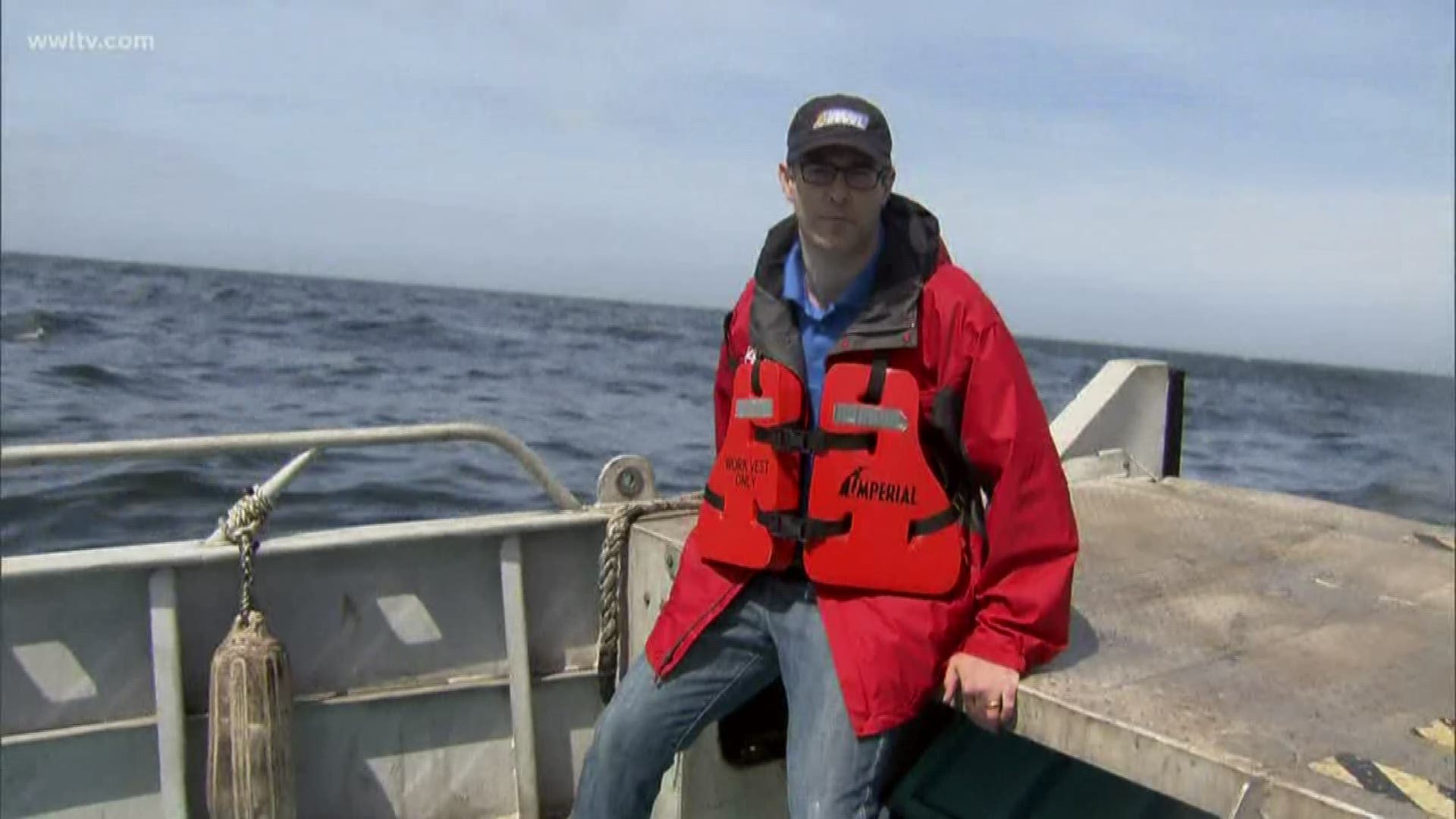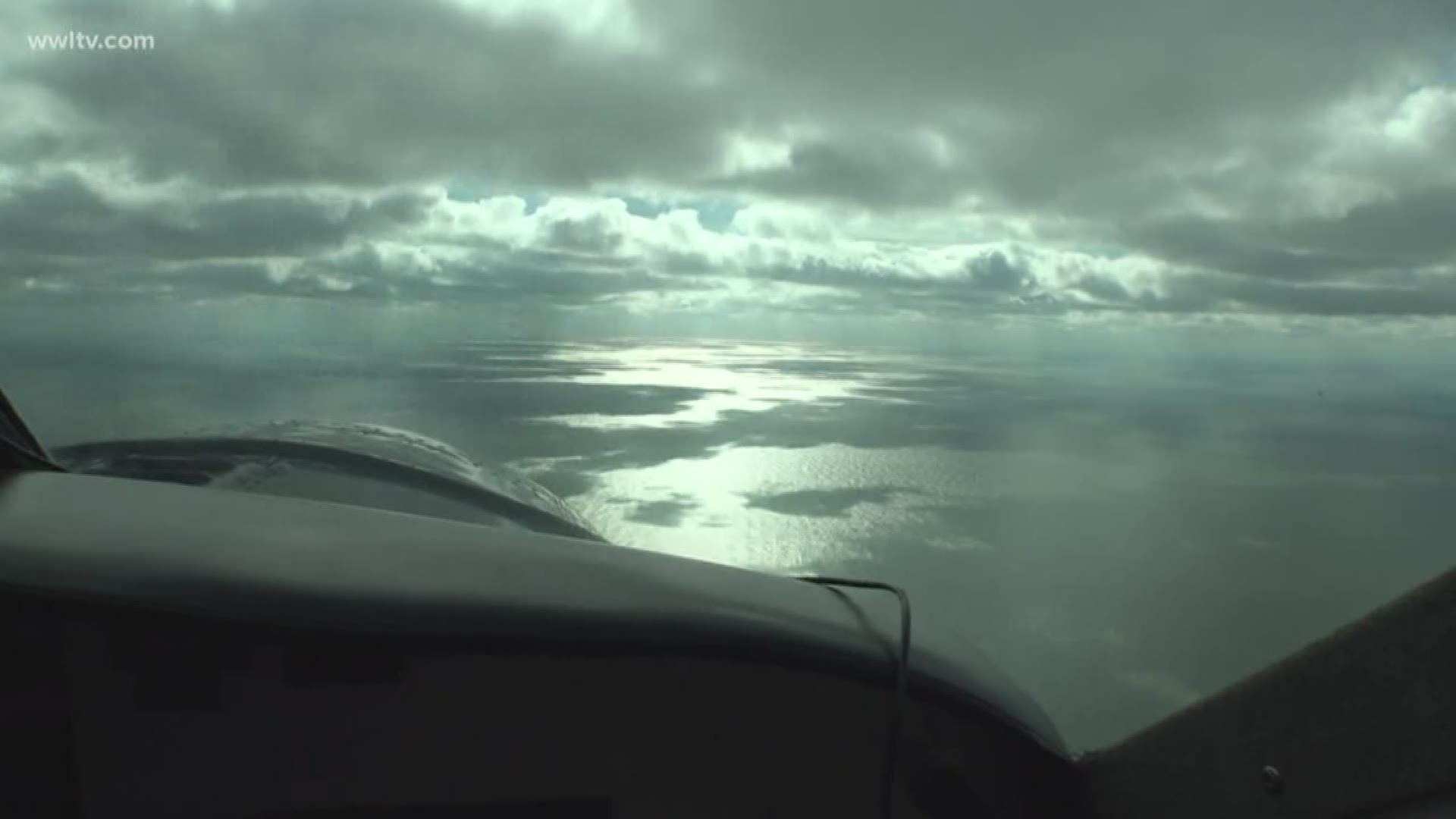A contractor for the U.S. Coast Guard has divers and robotic submarines at the site of the controversial 15-year-old Taylor Energy oil leak in the Gulf of Mexico, the longest-running offshore oil spill in U.S. history.
WWL-TV joined a CBS News crew and Florida State University oceanographer Ian MacDonald to capture the first video images of the new containment efforts at the scene of the leak, about 12 miles off the southernmost tip of the Mississippi River delta.
The supply ship Ocean Patriot was there, preparing to deploy a device called a containment dome to capture the leaking oil at the source, 450 feet below, and funnel it out of the water.
A Coast Guard spokesman confirmed that crews have been delayed by bad weather and were still “continuing to assess and prepare the site for containment” Thursday.
Meanwhile, Taylor Energy continued to try to block containment operations and disputed the larger spill-rate estimates the Coast Guard started using in October to justify its more aggressive push to stop the leak.
But the company began reporting larger spill volumes this week from its twice-daily overflights and issued a statement suggesting the work on-site by Coast Guard contractor Couvillion Group has exacerbated the problem.
“This is why Taylor Energy is raising the alarm about the junk science the Coast Guard is now using to justify activities that could destabilize the site and cause far more environmental harm than good,” the company’s statement said.
“The evidence is already apparent. The observed sheen volumes have spiked higher since the Coast Guard’s contractor began work at the site. The Coast Guard is acting recklessly and with unprecedented secrecy, underscoring Taylor Energy’s concern for the potential harm to the environment.”
Coast Guard spokesman Stephen Lehmann responded, saying:
“Our crews haven't reported any increased sheening and unfortunately we won't be able to provide any estimates until we've completed containment and can begin calculating flow rate.”
Taylor’s Mississippi Canyon Block 20-A platform was connected to 25 oil and gas wells when Hurricane Ivan toppled it in 2004. A mudslide that government scientists called “unprecedented” moved the platform more than 500 feet on the seafloor and covered the broken oil and gas wells with a 100-foot-thick layer of sediment.
Taylor was able to drill so-called "intervention wells" to intercept nine wells that it believed could have been leaking, to plug them permanently. The company says it’s spent more than $489 million on cleaning up, decommissioning and monitoring the site, and it’s ready to spend more to get the leak to stop.
But Taylor’s president, Will Pecue, said in an exclusive interview with WWL-TV last month that it’s been following warnings from scientists since 2013 not to drill any more intervention wells or disturb the area around the felled platform structure.
“You're going to stir it up, you're going to release that oil into the water column, and you're going to create a more adverse component to the water column, to the environment,” Pecue said.
Taylor believes no wells are actively leaking from the oil and gas reservoirs below the sea bed. Rather, its scientists have said weathered remnants of oil that leaked before the intervention wells were drilled has been escaping from under the mudslide. Letting it leak slowly is better for the environment than stirring it up, they concluded.
After accepting that position for years, the Coast Guard suddenly changed course in October. Coast Guard Capt. Kristi Luttrell, the federal on-scene coordinator for the Taylor spill, said at least one and possibly multiple wells were leaking. In mid-November, she partially federalized the spill response, hiring Belle Chasse-based Couvillion to deploy its containment domes and sticking Taylor with the bill.
Taylor had previously deployed its own containment domes, from 2009 to 2013, but they got clogged with sediment and did not collect much oil. Couvillion plans to use larger domes and crews plan to hook them to the downed platform’s metal support structure, so they won’t sit directly on the muddy sediment and might avoid getting gummed up.
In addition to fighting over where the oil is coming from, the amount of oil leaking has become a major controversy since last fall.
For more than a decade, the government accepted Taylor’s assessment that the leak was minor, only discharging about 10 gallons a day. But for years, environmental watchdogs and independent scientists reported larger volumes and questioned the official figures.
Then, last year, scientists hired by the government used new methods to estimate much larger spill volumes. MacDonald estimated in September that the rate was more than 4,000 gallons a day. And Oscar Garcia-Pineda, a former student of MacDonald’s, caused a stir when the government cited his report in federal court estimating the flow rate was anywhere from about 10,000 gallons a day to more than 30,000 gallons a day.
RELATED: How big is the 15-year-old oil spill near the Mouth of the Mississippi? It depends on who you ask
MacDonald said his observations this week make him even more confident that Taylor has been consistently under-reporting the spill volume.
“A gallon of oil, at a thin layer, a micron-thick layer (thinner than a human hair), covers a football field,” MacDonald said. “We have many, many, many football fields. How do they look at that and say that’s only 10 gallons, and why did the Coast Guard believe them?”
MacDonald was the first scientist to prove that BP was vastly understating the size of its massive spill in 2010. The company initially said the Deepwater Horizon rig explosion had caused 5,000 barrels of oil to leak each day, and MacDonald came back with a conservative estimate that it was actually 27,000 barrels per day. The government eventually settled on a spill-rate of about 60,000 barrels a day.
There are 42 gallons in a barrel.
Although MacDonald has worked for the government, he questions the Coast Guard’s long-standing policy of relying on the oil companies to report their own spills accurately.
“It’s troubling to me that sometimes the Coast Guard does not make use of the kinds of scientific evidence that would be available to it,” he said.
At the same time, MacDonald says national news reports comparing the Taylor spill to the Deepwater Horizon disaster aren’t helpful, either.
“I don’t think that serves the public well. I think we should be very careful in how we evaluate this. I think we should be conservative,” he said. “That doesn’t mean we should pretend it’s only 10 gallons a day. But let’s not call this the second Deepwater Horizon, when it’s not.”
The Deepwater Horizon spilled about 1.5 million gallons of BP’s oil into the Gulf each day for 87 days, dumping a total of 134 million gallons, according to a court ruling. Even using MacDonald’s daily estimate of 4,032 gallons a day over the full 5,307 days since Hurricane Ivan, the Taylor leak would have only accounted for about 21 million gallons by now, a sixth of BP’s total.
What’s more, BP’s oil floated from 40 miles further out to sully hundreds of miles of coastlines from Texas to Florida and left billions of dollars’ worth of damage to natural resources, such as fisheries, birds and marshland. But a 2013 government report found no discernable environmental impact from Taylor’s leak, and none of Taylor’s oil -- which can be “fingerprinted” to pinpoint its origin – has been reported on any shoreline.


